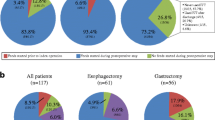Abstract
Background
Nutritional support influences the outcome of gastroenterological surgery, and enteral nutrition effectively mitigates postoperative complications in highly invasive surgery such as resection of esophageal cancer. However, feeding via jejunostomy can cause complications including mechanical obstruction, which could be life threatening. From 2009, we began enteral feeding via duodenostomy to reduce the likelihood of complications. In this study, we compared duodenostomy with the conventional jejunostomy feeding, mainly looking at the catheter-related complications.
Methods
The database records of 378 patients with esophageal cancer who underwent radical esophagectomy with retrosternal or posterior mediastinal gastric tube reconstruction in our department from January 1998 to December 2012 were examined. Of the 378 patients, 111 underwent feeding via duodenostomy (FD) and 267 underwent feeding via jejunostomy (FJ), and their records were reviewed for the following catheter-related complications: site infection, dislodgement, peritonitis, and mechanical obstruction.
Results
Mechanical obstruction occurred in 12 patients in the FJ group but none in the FD group (4.5 % vs. 0 %, P = 0.023). Of the 12 cases, 7 (58.3 %) required surgery of which 2 had bowel resection due to strangulated mechanical obstruction. Catheter site infection was seen in 14 cases in the FJ group, of which 2 (14.2 %) had peritonitis following catheter dislocation, while only one case of site infection was seen in the FD group (5.2 % vs. 0.9 %, P = 0.078).
Conclusions
Feeding via duodenectomy could be the procedure of choice since neither mechanical obstruction nor relaparotomy was seen during enteral feeding through this technique.




Similar content being viewed by others
References
Aiko S, Yoshizumi Y, Sugiura Y et al (2001) Beneficial effects of immediate enteral nutrition after esophageal cancer surgery. Surg Today 31:971–978
Bower RH, Talamini MA, Sax HC et al (1986) Postoperative enteral vs parenteral-nutrition—a randomized controlled trial. Arch Surg 121:1040–1045
Heslin MJ, Latkany L, Leung D et al (1997) A prospective, randomized trial of early enteral feeding after resection of upper gastrointestinal malignancy. Ann Surg 226:567–577
Gabor S, Renner H, Matzi V et al (2005) Early enteral feeding compared with parenteral nutrition after oesophageal or oesophagogastric resection and reconstruction. Br J Nutr 93:509–513
Han-Geurts IJM, Verhoef C, Tilanus HW (2004) Relaparotomy following complications of feeding jejunostomy in esophageal surgery. Dig Surg 21:192–196
Venskutonis D, Bradulskis S, Adamonis K, Urbanavicius L (2007) Witzel catheter feeding jejunostomy: is it safe? Dig Surg 24:349–353
Schunn CDG, Daly JM (1995) Small bowel necrosis associated with postoperative jejunal tube feeding. J Am Coll Surg 180:410–416
Sobin LH, Wittekind C (2002) International Union Against Cancer (UICC) TNM classification of malignant tumors, 6th edn. Wiley, New York
Lassen K, Kjaeve J, Fetveit T et al (2008) Allowing normal food at will after major upper gastrointestinal surgery does not increase morbidity a randomized multicenter trial. Ann Surg 247:721–729
Bozzetti F, Migliavacca S, Scotti A et al (1982) Impact of cancer, type, site, stage and treatment on the nutritional status of patients. Ann Surg 196:170–179
Deitch EA (1994) Bacterial translocation: the influence of dietary variables. Gut 35:S23–S27
Han-Geurts IJM, Hop WC, Verhoef C et al (2007) Randomized clinical trial comparing feeding jejunostomy with nasoduodenal tube placement in patients undergoing oesophagectomy. Br J Surg 94:31–35
Wani ML, Ahangar AG, Lone GN et al (2010) Feeding jejunostomy: does the benefit overweight the risk (a retrospective study from a single centre). Int J Surg 8:90–387
Shiraishi T, Kawahara K, Yamamoto S et al (2005) Postoperative nutritional management after esophagectomy: is TPN the standard of nutritional care? Int Surg 90:30–35
Gupta V (2009) Benefits versus risks: a prospective audit feeding jejunostomy during esophagectomy. World J Surg 33:1432–1438
Couper G (2011) Jejunostomy after oesophagectomy: a review of evidence and current practice. Proc Nutr Soc 70:316–320
Alverdy J, Chi HS, Sheldon GF (1985) The effect of parenteral nutrition on gastrointestinal immunity. The importance of enteral stimulation. Ann Surg 202:681–684
Mathus-Vliegen LM, Koning H (1999) Percutaneous endoscopic gastrostomy and gastrojejunostomy: a critical reappraisal of patient selection, tube function and the feasibility of nutritional support during extended follow-up. Gastrointest Endosc 50:746–754
Swann HM, Sweet DC, Michel K (1997) Complications associated with use of jejunostomy tubes in dogs and cats: 40 cases (1989–1994). J Am Vet Med Assoc 210:1764–1767
Blumenstein I, Shastri YM, Stein J (2014) Gastroenteric tube feeding: techniques, problems and solutions. World J Gastroenterol 20(26):8505–8524
Montejo JC, Grau T, Acosta J et al (2002) Multicenter, prospective, randomized, single-blind study comparing the efficacy and gastrointestinal complications of early jejunal feeding with early gastric feeding in critically ill patients. Crit Care Med 30:796–800
Srinathan SK, Hamin T, Walter S et al (2013) Jejunostomy tube feeding in patients undergoing esophagectomy. Can J Surg 56:409–414
Yagi M, Hashimoto T, Nezuka H et al (1999) Complications associated with enteral nutrition using catheter jejunostomy after esophagectomy. Surg Today 29:214–218
Funding
None.
Conflict of interest
None.
Author information
Authors and Affiliations
Corresponding author
Rights and permissions
About this article
Cite this article
Oya, H., Koike, M., Iwata, N. et al. Feeding Duodenostomy Decreases the Incidence of Mechanical Obstruction After Radical Esophageal Cancer Surgery. World J Surg 39, 1105–1110 (2015). https://doi.org/10.1007/s00268-015-2952-5
Published:
Issue Date:
DOI: https://doi.org/10.1007/s00268-015-2952-5




